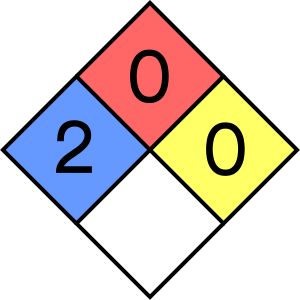CHLOROFORM
Basic information
- Chemical formula(s): \({\rm CHCl_3}\)
- Other names: trichloromethane, methane trichloride, formyl trichloride
- CAS: 67-66-3
- International Chemical Safety Card (ICSC): 0027
- Flammability: no
- NOAA’s description: clear colourless liquid with a characteristic odour; denser than water and slightly soluble in water, hence sinks in water; nonflammable under most conditions, but burns under extreme conditions; may cause illness by inhalation, skin absorption or ingestion
NFPA 704 (fire diamond)

- Health (blue): 2 - intense or continued but not chronic exposure could cause temporary incapacitation or possible residual injury.
- Flammability (red): 0 - will not burn under typical fire conditions, will not burn in air unless exposed to a temperature of 820 °C for more than 5 minutes.
- Instability–reactivity (yellow): 0 - normally stable, even under fire exposure conditions, and is not reactive with water.
- Special notice (white): -
Hazard statements
| Code | Phrase |
|---|---|
| H302 | harmful if swallowed |
| H315 | causes skin irritation |
| H319 | causes serious eye irritation |
| H331 | toxic if inhaled |
| H336 | may cause drowsiness or dizziness |
| H351 | suspected of causing cancer |
| H361d | suspected of damaging the unborn child |
| H372 | causes damage to organs through prolonged or repeated exposure |
Precautionary statements
| Code | Phrase |
|---|---|
| P201 | obtain special instructions before use |
| P202 | do not handle until all safety precautions have been read and understood |
| P235 | keep cool |
| P260 | do not breathe dust/fume/gas/mist/vapours/spray |
| P264 | wash … thoroughly after handling |
| P270 | do not eat, drink or smoke when using this product |
| P271 | use only outdoors or in a well-ventilated area |
| P280 | wear protective gloves/protective clothing/eye protection/face protection |
| P281 | use personal protective equipment as required |
| P301+P330+P331 | IF SWALLOWED: rinse mouth, do NOT induce vomiting |
| P302+P352 | IF ON SKIN: wash with soap and water |
| P304+P340 | IF INHALED: remove victim to fresh air and keep at rest in a position comfortable for breathing |
| P305+P351+P338 | IF IN EYES: rinse continuously with water for several minutes, remove contact lenses if present and easy to do, continue rinsing |
| P308+P313 | IF EXPOSED OR CONCERNED: get medical advice/attention |
| P310 | immediately call the ETH Emergency Desk: +41 44 342 11 88 (from mobile) or 888 (from landline) |
| P311 | call the ETH Emergency Desk: +41 44 342 11 88 (from mobile) or 888 (from landline) |
| P314 | get medical advice/attention if you feel unwell |
| P332+P313 | IF SKIN IRRITATION OCCURS: get medical advice/attention |
| P337+P313 | IF EYE IRRITATION PERSISTS: get medical advice/attention |
| P362 | take off contaminated clothing |
| P403+P233 | store in a well ventilated place, keep container tightly closed |
| P405 | store locked up |
| P501 | dispose of contents/container to HCI-Shop |
Protective measures
Gloves
Occupational Safety and Health Act of 1970 and OSHA Glove Selection Chart categorize gloves into four protection levels (very good, good, fair, poor (not recommended)) for given chemical. The levels of protection against chloroform for four types of gloves are:
- Neoprene: good for limited service.
- Natural latex or rubber: poor (not recommended).
- Buthyl: poor (not recommended).
- Nitrile: poor (not recommended).
Safety goggles
- Always wear safety goggles when handling the chemical. Corrective glasses are not considered safety googles.
- Handle the chemical inside the fume hood only (with exception of moving the closed bottle to and from the storage cabinet).
Clothing
- Wear long trousers and fully covered shoes.
- Contact lenses are forbidden while working with chemical substances, even in combination with safety glasses.
- Do not wear cosmetics.
- Do not wear synthetic clothing while working with flammable liquids or gases or when a hazard is present as these materials tend to melt and stick to exposed skin.
- Do not wear headphones.
Spill management
- Use personal protective equipment.
- Avoid dust formation, avoid breathing dust, use only under the fume hood.
- Avoid breathing vapors or mist.
- Ensure adequate ventilation.
- Evacuate personnel to safe areas.
- Sweep up without creating dust and arrange disposal.
- Do not let it enter drain.
- If a spill happened outside the fume hood (on the floor or desktop) contact Dr. Jakub Tkaczuk (+41 44 632 31 62) and the ETH Emergency Desk (+41 44 342 11 88 from mobile or 888 from landline).